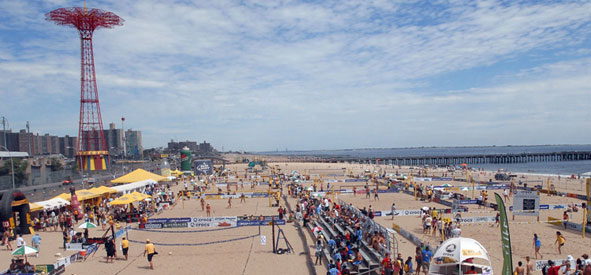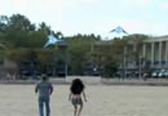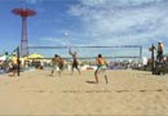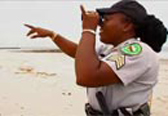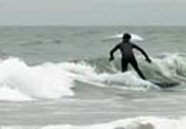Amusement Park Culture
Find information about NYC’s beaches, their hours, and locations at the Beaches webpage.
By the turn of the 20th century, with the help of improved rail and ferry transportation, a thriving amusement park culture at Coney Island, Rockaway Beach, and the South Shore of Staten Island was serving the city's skyrocketing population. These areas often featured a festive atmosphere, with large amusement parks and lively and sometimes bawdy establishments.
Coney Island, Brooklyn
Coney Island's days as a pleasure ground date back as far as the 1820s, when private interests established hotels along the shore, but from the 1890s to World War I, amusement parks sprouted along the beach. George C. Til-you's Steeplechase Park was established in 1895 and centralized many different rides and amusements in one location. Another outlet, Luna Park designed by Frederick Thompson and Elmer Dundy, whom Til-you recruited opened in 1904. Coney Island's popularity only increased when the BMT subway connection was completed in 1920.
The famous boardwalk opened with great fanfare on May 15, 1923, and was realigned and rebuilt as part of overall improvements by the Parks Department between 1938 and 1941. The pier at West 17th Street, first built by George Til-you in 1904 as part of Steeplechase Park, was acquired by New York City in 1921, and Parks assumed jurisdiction, along with the beach, in 1938. The agency moved to shut down many of the honky-tonk establishments which operated along the boardwalk, and even underneath. As part of this effort, in-house Parks designers created new standardized, streamlined refreshment stands
After World War II, as the local amusement park industry declined, the New York Aquarium was relocated from Battery Park in an effort to sustain Coney Island as a tourist destination. Through the 1960s, fireworks displays lit the summer night sky as an enticement to draw visitors to Coney Island.
Parachute Jump
The Parachute Jump, located on the southwest corner of the block between Surf Avenue, the Riegelmann Boardwalk, West 16th Street, and West 19th Street, was erected in 1939 for the New York World's Fair of 1939-40 at Flushing Meadows in Queens (now Flushing Meadows Corona Park). It was moved to its present location soon after, in 1941. In 2002, Parks spent $5 million to stabilize the structure, and in 2006, the structure was illuminated with festive, continually changing lighting.
The Cyclone
Covering 3000 feet of track in a minute and fifty seconds, the Cyclone carries 24 passengers and reaches speeds of 60 miles per hour. Its biggest drop is 85 feet at a descent angle of 58.1 degrees, making the Cyclone the second-steepest wooden roller coaster in the world. Today, the Cyclone stands as one of the last remnants of “ The Nation's Playground,” as Coney Island was known in its heyday. The famed roller coaster was landmarked by the City in 1988.
Midland and South Beaches, Staten Island
At the end of the 19th century, private developers transformed Staten Island's Midland and South Beaches by adding hotels, bathing pavilions, theaters, beer gardens, carousels, and Ferris wheels. The most famous of Staten Island's Coney Island-style amusement parks was Happyland Amusement Park, which opened at South Beach in 1906. Though the boardwalk thrived throughout the 1910s and 20s, fires, water pollution and the Depression took their toll on the beachfront resort area, and the crowds eventually disappeared.
Beaches No Longer
Although the City eventually made great progress in reclaiming beaches from private entrepreneurs and pollution, or even by constructing them out of nothing (as in Orchard Beach), there are also examples of beaches that once were but exist no longer. Bensonhurst Park in New Utrecht featured rustic pavilions and a bathing beach on what is now the Belt Parkway and its landscaped bike and pedestrian path. And though it was never an official city park, North Beach near East Elmhurst in Queens was once a resort with a swimming beach; the site became La Guardia Airport.
